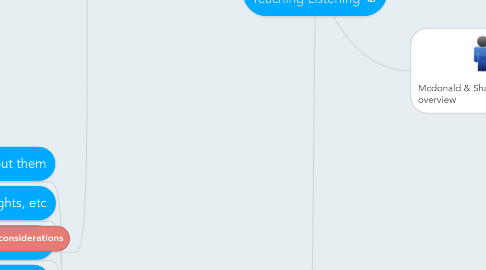
1. Activities
1.1. Pre-Listening Activities
1.1.1. Looking at pictures and talking about them
1.1.2. Looking at list of items/thoughts, etc
1.1.3. Making lists of posiblities/ideas/suggestions
1.1.4. Reading a text
1.1.5. Reading through questions
1.1.6. Labelling
1.1.7. Completing part of a chart
1.1.8. Predicting/speculating
1.1.9. Pre-viewing language
1.1.10. informal Teacher talk & class discussion
1.2. While- Listening activities
1.2.1. Labelling
1.2.2. Using lists
1.2.3. True/false
1.2.4. Multiple-choice questions
1.2.5. Text completion (gap-filling)
1.2.6. Spotting mistakes
1.2.7. Predicting
1.2.8. Seeking specific items of information
1.2.9. Marking/checking items in pictures
1.2.10. Matching pictures with what is heard
1.2.11. Storyline picture sets
1.2.12. Putting pictures in order
1.2.13. Completing pictures
1.2.14. Picture drawing
1.2.15. Carrying out actions
1.2.16. Following a route
1.2.17. Completing grids
1.2.18. Form/chart completition
1.3. Post-Listening activities
1.3.1. Form/chart completion
1.3.2. Extending lists.
1.3.3. Sequencing/grading
1.3.4. Matching with a reading text
1.3.5. Extending notes into written responses
1.3.6. Summarising
1.3.7. Using information for problem solving and decision making activities
1.3.8. Jigsaw listening
1.3.9. Identifying relationships between speakers
1.3.10. Establishing mood/attitude/behaviour of the speaker
1.3.11. Role play/simulation
1.3.12. Dictation
2. Organising Principles
2.1. Reading & Listening; similarities
2.1.1. Attention
2.1.1.1. Listening
2.1.1.2. Reading
2.1.2. Recognition
2.1.2.1. Hearing
2.1.2.2. Seeing
2.2. Differences
2.2.1. The communicative medium which separates the two skills
2.2.2. the reception stage of listening
2.3. Brown & Yule
2.3.1. Distiguish
2.3.1.1. Transactional
2.3.1.2. Interactional
2.4. List 9
2.4.1. Called medium factors
2.4.1.1. listener must do to process speech
2.5. Richards
2.5.1. List 7
2.5.1.1. Called production factors
2.5.1.1.1. Clausal basis of speech
2.5.1.1.2. Reduced forms
2.5.1.1.3. Ungrammatical forms
2.5.1.1.4. Pausing & speech errors
2.5.1.1.5. Rate of delivery
2.5.1.1.6. Rhythm & stress
2.5.1.1.7. Cohesive Devices
2.6. Processing sound, meaning & response
2.6.1. Have 2 kinds of knowledge
2.6.1.1. knowledge of syntax of the target language
2.6.1.2. knowledge of the world
2.7. Social Context McGregor
2.7.1. List the roles & expectations
2.7.1.1. Such as
2.7.1.1.1. Participant
2.7.1.1.2. Addressee
2.7.1.1.3. Auditor
2.7.1.1.4. Overhearer
2.7.1.1.5. Judge
2.8. Classroom considerations
2.8.1. abstractness of content
2.8.2. cultural aspects of the Content)
2.8.3. number of information points
2.8.4. media support provided
2.8.5. length of extract
2.8.6. level of linguistic ability
2.8.7. 'real-life listening'
2.8.7.1. allows access to environmental cues
2.8.7.2. listening segments come in short chunks
2.8.7.3. show of reciprocity and typically requires frequent listener response
2.8.8. the characteristic of the relationship
2.8.8.1. between
2.8.8.1.1. text and the reader
3. Integrating Listening
3.1. a genuine response to a spoken 'text' is to respond in kind
3.2. many uses of 'listening' in the language classroom
3.2.1. based on a taped monologue or dialogue
